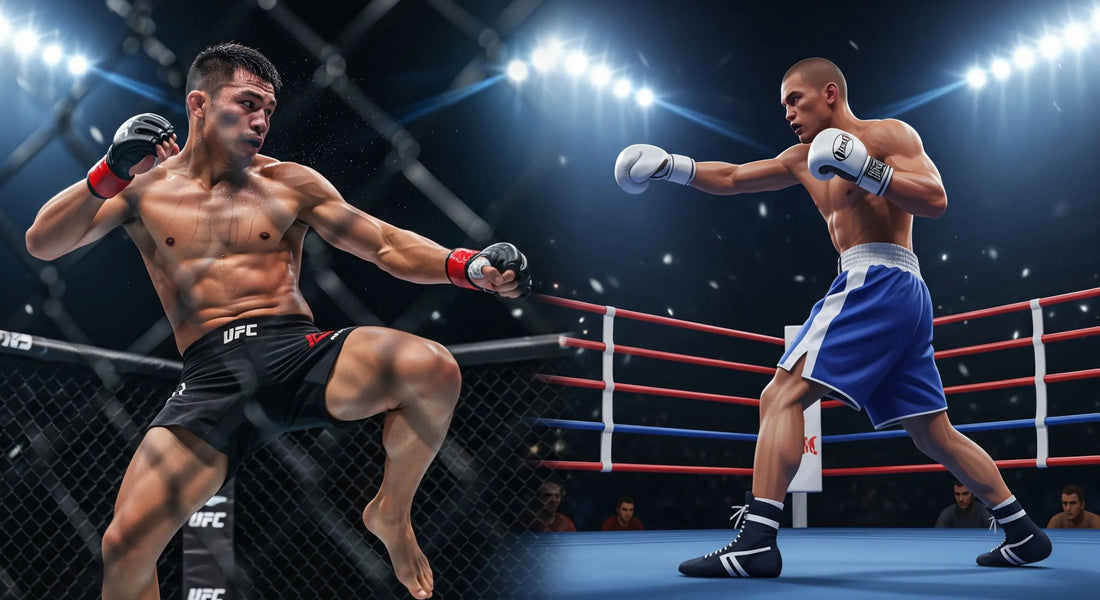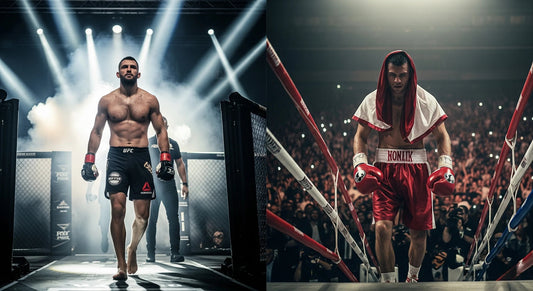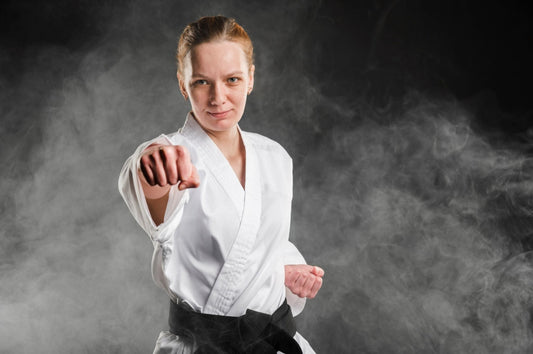
Difference between Muay Thai and MMA
Introduction
Combat sports have gained significant popularity worldwide in recent decades. Whether it’s the electrifying knockouts in the UFC octagon or the thunderous kicks in a Muay Thai ring, both sports captivate audiences with their intensity and skill. But here’s the catch: while both Muay Thai and MMA involve punches, kicks, and physical grit, they’re very different at their core.

Understanding these differences isn’t just for fighters; it's for anyone curious about fitness, self-defence, or martial arts culture. Muay Thai, often called the “Art of Eight Limbs,” focuses on striking with fists, elbows, knees, and shins. On the other hand, MMA (Mixed Martial Arts) is a melting pot of various combat styles blending striking, wrestling, and submissions into one all-encompassing sport.
So, which one is harder? Which one is more effective in real life? Which one suits your personality and fitness goals better? In this article, we’ll break everything down step by step, covering history, techniques, rules, training, and much more so you’ll walk away with a crystal-clear understanding of the difference between Muay Thai and MMA.
Origins and History
History of Muay Thai
Muay Thai traces its roots back centuries in Thailand. Originally developed as a battlefield combat system, it evolved into a cultural martial art that became deeply woven into Thai traditions. Fighters were once trained for war, using knees and elbows as weapons in hand-to-hand combat. Over time, these skills transformed into a competitive sport, with fighters showcasing their techniques in village festivals and royal ceremonies.

In modern times, Muay Thai is both a national sport and a cultural heritage of Thailand. Stadiums in Bangkok, like Lumpinee and Rajadamnern, have become sacred grounds where fighters prove themselves. Today, Muay Thai is practised worldwide, not only as a fighting art but also as a fitness discipline and self-defence method.
History of MMA
MMA, unlike Muay Thai, is relatively new. While the roots of mixed-style fighting go back to ancient Greece with Pankration (a brutal Olympic sport combining boxing and wrestling), the modern version of MMA rose to fame in the 1990s with the birth of the Ultimate Fighting Championship (UFC).

Initially marketed as a no-holds-barred fight to see which martial art was superior, MMA evolved into a structured sport with rules, weight classes, and safety measures. Brazilian Jiu-Jitsu, wrestling, boxing, Muay Thai, and kickboxing all became key elements in the MMA toolkit.
Traditional vs. Modern Development
The biggest difference in history is that Muay Thai is a singular, traditional martial art with centuries of refinement, while MMA is a hybrid modern sport designed to combine the best techniques from multiple disciplines. Muay Thai fighters often dedicate their lives to perfecting one art, while MMA fighters must spread their training across striking, grappling, and submissions.
Core Fighting Styles
Muay Thai – The Art of Eight Limbs
Muay Thai’s nickname, “The Art of Eight Limbs,” comes from its use of eight points of contact: fists, elbows, knees, and shins. Unlike Western boxing, which uses only punches, Muay Thai allows fighters to unleash powerful elbow strikes, crushing knee attacks, and devastating roundhouse kicks.
Clinch fighting is another signature aspect of Muay Thai. Fighters lock arms around their opponent’s neck or torso, controlling posture while delivering knees and elbows. This close-range combat makes Muay Thai especially dangerous, as a skilled fighter can finish a fight in seconds from the clinch.
MMA – A Blend of Martial Arts
MMA is like a buffet of fighting styles. You don’t stick to one dish, you take a bit of everything. A well-rounded MMA fighter must train in multiple disciplines: striking (often using Muay Thai and boxing), grappling (wrestling and Jiu-Jitsu), and sometimes even karate or judo.
The goal isn’t to master just one art but to be versatile. If you’re a striker facing a wrestler, you need takedown defense. If you’re a grappler fighting a boxer, you need to avoid punches while closing the distance. MMA is essentially the art of adapting to any opponent, anywhere, anytime.
Key Philosophical Differences
Muay Thai is about discipline, repetition, and mastery of striking. MMA, on the other hand, is about adaptability, problem-solving, and versatility. Think of Muay Thai as a sharpened sword, lethal and specialized. MMA, however, is more like a Swiss Army knife versatile and prepared for any scenario.
Rules and Regulations
Muay Thai Rules
Muay Thai fights typically take place in a square boxing-style ring, with five three-minute rounds (in professional bouts). Fighters are allowed to use punches, kicks, knees, and elbows. Clinching is legal, but ground fighting is not once an opponent goes down, the referee steps in.
Scoring is based on effective strikes, aggression, dominance in the clinch, and overall control of the fight. Judges value powerful kicks and knees over lighter punches, and clean technique often outweighs sheer volume.
MMA Rules
MMA fights usually occur inside a cage, often an octagon shape. Depending on the promotion, bouts last three or five five-minute rounds. The rules are broader; fighters can strike standing up or on the ground, attempt submissions, or use wrestling takedowns.
Illegal moves include eye gouging, groin strikes, biting, and strikes to the back of the head. Beyond that, almost everything else is fair game. Scoring follows the 10-point must system, similar to boxing, with judges looking at striking, grappling, octagon control, and effective aggression.
Similarities and Differences in Scoring
The big distinction is that Muay Thai is purely striking-based, while MMA includes ground fighting. In Muay Thai, winning the clinch and landing clean kicks are crucial. In MMA, a fighter can dominate simply through wrestling control or submissions, even without flashy strikes.
Techniques and Fighting Approaches
Striking in Muay Thai
Muay Thai striking is known for its precision and raw power. The roundhouse kick, delivered with the shin, is considered one of the most destructive strikes in martial arts. Elbows can slice open an opponent’s face, while knees can knock the wind out of them instantly.

Footwork in Muay Thai tends to be straightforward and calculated rather than flashy. Fighters stay balanced, looking for opportunities to counter and punish mistakes. The rhythm is slower but brutal; each strike carries fight-ending potential.
Striking and Grappling in MMA
MMA striking borrows heavily from Muay Thai, boxing, and kickboxing. Fighters mix punches, leg kicks, and head kicks with wrestling takedowns and Brazilian Jiu-Jitsu submissions. Unlike Muay Thai, MMA fights constantly shift between ranges standing, clinching, and ground fighting.

This unpredictability makes MMA highly strategic. A fighter may look dominant on the feet, only to be taken down and controlled for the rest of the round. The combination of striking and grappling forces fighters to train for every possible scenario.
Defensive Strategies
Muay Thai defence revolves around blocking with shins, using elbows to deflect, and clinching to neutralise opponents. MMA defence, however, has to cover far more fighters who must defend against punches, kicks, takedowns, and submission attempts.
In short, Muay Thai defence is specialized; MMA defence is diversified.
Training Methods
Traditional Muay Thai Training
Muay Thai training in Thailand is a lifestyle more than just a workout. Fighters often begin training at a very young age, sometimes as early as six or seven. The training environment is usually a camp where fighters live, eat, and breathe Muay Thai daily. Mornings often begin with long-distance running, followed by pad work, bag work, clinch training, and sparring. Repetition is when key fighters perform the same kicks, elbows, and knees thousands of times until they become second nature.

Another aspect of Muay Thai training is the mental discipline. Respect for teachers (Kru), rituals before fights (Wai Kru Ram Muay), and the cultural emphasis on humility are integral parts of the training. Strength training is minimal compared to Western approaches; instead, conditioning is built naturally through gruelling daily routines.
In short, Muay Thai training is raw, traditional, and deeply tied to cultural values. The emphasis is on sharpening the striking weapons rather than diversifying skill sets.
MMA Training Camps
MMA training is much more modern and varied. Fighters split their time between different disciplines: striking (boxing, Muay Thai, kickboxing), grappling (wrestling, Brazilian Jiu-Jitsu), and strength/conditioning. Instead of focusing on one art, fighters build their weekly routines around balancing multiple skill sets.

An MMA fighter might spend one morning working wrestling takedowns, the evening sparring in boxing, and the next day practicing submission escapes. Because MMA is about versatility, fighters must constantly evolve their game. Training camps often employ nutritionists, strength coaches, and sports psychologists to maximize performance.
This makes MMA training broader, more scientific, and highly demanding compared to the traditional camp-style training of Muay Thai.
Strength and Conditioning
While Muay Thai training builds conditioning through pad work, sparring, and endurance runs, MMA incorporates advanced strength and conditioning programs. Fighters lift weights, do explosive plyometrics, and engage in HIIT workouts designed to improve power and stamina for grappling-heavy matches.
MMA fighters need not just striking endurance but also grappling strength to survive prolonged ground battles. Muay Thai fighters, meanwhile, emphasize toughness, shin conditioning, and cardio for five-round wars.
Equipment and Gear
Muay Thai Equipment
In Muay Thai, gear is relatively easy. Fighters use boxing gloves, hand wraps, shin guards (for training), and traditional Muay Thai shorts. The equipment is designed to allow maximum freedom of movement, especially for kicks and knees.

A signature item in Muay Thai is the Mongkhon, a ceremonial headpiece worn during the pre-fight ritual dance. While it’s not used in training, it represents respect and tradition, setting Muay Thai apart culturally from MMA.
MMA Equipment
MMA gear, on the other hand, is slightly different. Fighters wear smaller, open-finger gloves (usually 4 ounces) that allow them to strike and grapple. Unlike Muay Thai, where big gloves soften blows, MMA gloves make strikes more dangerous but necessary for grappling transitions.

Fighters also use mouthguards, groin protectors, and MMA shorts designed for mobility. In training, they often use additional safety gear like headgear, shin guards, and wrestling mats for grappling drills.
Safety Differences
Gear differences reflect the nature of the sport. Muay Thai gloves are bigger, protecting both fighters from excessive damage while focusing on striking. MMA gloves are smaller, meaning strikes land harder, but they’re necessary for submissions. In terms of safety, Muay Thai has more padding, while MMA exposes fighters to a wider range of risks.
Competitive Environment
Muay Thai Rings vs. MMA Cages
A major visual difference between the two sports is where the fights happen. Muay Thai takes place in a square boxing-style ring. The ropes are part of the strategy fighters use to trap opponents, clinch, or bounce back after strikes.
MMA, on the other hand, is fought in a cage (often octagonal in the UFC). The cage prevents fighters from falling out and plays a role in grappling strategy. Wrestlers often press opponents against the cage to control them, a tactic that doesn’t exist in Muay Thai.
Fight Durations and Rounds
Professional Muay Thai fights usually consist of five rounds of three minutes each. Interestingly, the first round is often slower, almost like a warm-up, as fighters size each other up and show respect. The intensity usually peaks in rounds three and four before calming down again in the final round if a knockout hasn’t occurred.
MMA fights are generally three rounds of five minutes (for non-title fights) and five rounds for title fights or main events. The longer rounds make MMA physically demanding, as fighters must prepare for striking, grappling, and ground control all in the same round.
Spectator Experience
Watching a Muay Thai fight is often a cultural experience, with live music (Sarama) played throughout the bout, rituals, and a heavy sense of tradition. The crowd reacts differently, cheering for clean kicks and strong clinch work rather than just knockouts.
MMA, however, is more of a global spectacle. The walkouts, flashy lights, and dramatic commentary make it feel like an entertainment event as much as a sport. Fans cheer loudly for knockouts, submissions, and intense grappling exchanges.
Global Popularity
Muay Thai in Thailand and Abroad
In Thailand, Muay Thai isn’t just a sport it's a way of life. Stadiums in Bangkok host fights every week, and children grow up idolizing famous fighters. Beyond Thailand, Muay Thai has spread across the globe, with gyms in Europe, the U.S., and South America offering classes for fitness and fighting.
Still, Muay Thai remains somewhat niche compared to MMA. While hardcore martial artists admire its techniques, it hasn’t achieved the same mainstream recognition outside Thailand.
MMA’s Worldwide Growth
MMA exploded onto the global stage thanks to organizations like the UFC, Bellator, and ONE Championship. With television deals, pay-per-view events, and celebrity fighters like Conor McGregor, MMA has become one of the fastest-growing sports in the world.
Unlike Muay Thai, which is heavily tied to Thailand, MMA has a global identity. Fighters from Brazil, Russia, the U.S., Nigeria, and beyond compete at the highest levels, making it a truly international sport.
Media and Entertainment Influence
Another reason MMA outshines Muay Thai in global popularity is its media presence. UFC events dominate sports news, highlight reels flood social media, and fighters become household names. Muay Thai, despite its effectiveness, often plays a supporting role within MMA rather than standing alone in the mainstream spotlight.
Physical and Mental Demands
Muay Thai Fighter’s Discipline
Being a Muay Thai fighter requires incredible discipline, physically and mentally. Fighters train multiple times a day, often under brutal heat, with routines that push endurance and mental toughness to the limit. Long runs in the morning, hours of pad work, clinch sparring, and conditioning drills build not only strength but also resilience.
Beyond physical conditioning, Muay Thai fighters embody respect and humility. The culture of Muay Thai places strong emphasis on showing honor to teachers, opponents, and the sport itself. The Wai Kru Ram Muay ritual performed before battles is more than just a dance, it's a symbolic display of respect and mental focus.
Mental discipline in Muay Thai is patience and perseverance. Fighters learn to take damage, stay calm under pressure, and keep pushing forward even when exhausted. This unwavering mindset makes Muay Thai practitioners among the toughest fighters in the combat sports world.
MMA Fighter’s Versatility
MMA demands another kind of athleticism. Unlike Muay Thai, where fighters focus almost entirely on striking, MMA fighters must excel in multiple disciplines. This means training for striking, grappling, wrestling, and submissions each requiring a unique skill set.
The mental challenge is equally intense. Fighters must constantly adapt, switching between styles mid-fight. One round may involve stand-up striking, while the next could be spent defending takedowns and escaping submissions. This versatility requires a high combat IQ and the ability to think several moves ahead.
MMA fighters also face grueling fight camps, where the balance between striking, grappling, strength training, and recovery is carefully managed. Unlike Muay Thai, which is steeped in tradition, MMA camps are highly scientific, with nutritionists, strength coaches, and even psychologists working together to prepare the fighter.
Psychological Aspects of Combat
Both sports push fighters to their psychological limits, but in different ways. Muay Thai tests mental toughness through repetition, endurance, and embracing pain. Fighters are expected to remain calm while absorbing strikes and delivering counterattacks with precision.
MMA tests adaptability and strategic thinking. Fighters must overcome fear of the unknown, as their opponent could dominate in areas they’re weaker in. The mental stress of preparing for multiple fighting styles makes MMA psychologically demanding on a different level.
In short, Muay Thai shapes unshakable warriors with a narrow but sharp focus, while MMA produces versatile, strategic athletes who must stay mentally sharp under constant unpredictability.
Advantages of Each Sport
Why Choose Muay Thai?
Muay Thai offers unmatched striking ability. If you want to master powerful kicks, devastating elbows, and close-range knee strikes, Muay Thai is the way to go. It also builds incredible toughness physically and mentally. Fighters condition their shins, strengthen their core, and develop the ability to withstand punishment while maintaining composure.
Beyond fighting, Muay Thai is an excellent workout. The combination of cardio, strength, and agility training makes it ideal for anyone seeking fitness with a combat edge. It also carries cultural depth, with traditions that emphasize respect, humility, and discipline.
In short, Muay Thai is perfect for someone who wants to specialize in striking, improve fitness, and embrace martial arts as a cultural journey.
Why Choose MMA?
MMA, on the other hand, is the ultimate test of well-rounded combat skills. If you’re looking to be prepared for any fighting situation, standing up, clinching, or on the ground MMA is unbeatable. It teaches versatility, adaptability, and resilience under pressure.
For athletes who love competition, MMA also offers more global opportunities. Organizations like the UFC and Bellator provide platforms for fighters to become worldwide stars. MMA’s exposure makes it appealing for those chasing fame, recognition, and financial reward.
Which One Is Better for Fitness?
When it comes to fitness, both sports have huge benefits. Muay Thai builds endurance, agility, and toughness through intense striking and cardio sessions. MMA, however, offers a more complete workout because it involves striking, grappling, and strength training.
If your goal is to get lean, strong, and conditioned for explosive movements, MMA has the edge. But if you want to master striking while getting an amazing cardio workout, Muay Thai is the ideal choice.
Career Opportunities
Muay Thai Fighters’ Career Paths
In Thailand, Muay Thai fighters often start young and fight frequently, sometimes having hundreds of fights in their careers. However, the financial rewards are relatively small compared to MMA. Many fighters come from humble backgrounds, and Muay Thai offers them a way to support their families.
Outside Thailand, professional Muay Thai opportunities are limited but growing. Kickboxing organizations and Muay Thai promotions in Europe and Asia are creating platforms for fighters to earn more recognition, though it’s still not as lucrative as MMA.
MMA Fighters and UFC
MMA offers far greater career opportunities in terms of exposure and money. Fighters who reach organizations like the UFC, ONE Championship, or Bellator can earn significant paydays, sponsorships, and fame. Even mid-level fighters often earn more than many top-level Muay Thai fighters.
The global reach of MMA means fighters from around the world can rise to stardom. Conor McGregor, Khabib Nurmagomedov, and Israel Adesanya are proof of how MMA can create international icons.
Financial Comparison
Financially, MMA is far ahead of Muay Thai. The pay-per-view model, sponsorship deals, and global fan base make MMA a more rewarding career path. Muay Thai, while deeply respected, is still mostly limited to regional competitions and traditional stadium fights with smaller payouts.
Self-Defense Applications
Muay Thai for Street Defense
Muay Thai is one of the best striking arts for self-defense. Its powerful kicks, elbows, and knees can quickly neutralize an attacker. The clinch is especially effective in close-range situations, allowing you to control an opponent while delivering strikes.
However, Muay Thai lacks ground fighting techniques. If a fight goes to the ground, a pure Muay Thai practitioner may struggle without grappling experience.
MMA for Real-Life Situations
MMA is arguably the most practical martial art for self-defense because it combines striking and grappling. In real-life situations, fights can quickly end up on the ground, and MMA fighters are well-prepared for that. They can strike, defend takedowns, and apply submissions if needed.
However, MMA techniques require more space and training time to master. In a street scenario, the flashy moves seen in MMA aren’t always practical.
Which One Is More Practical?
Both arts are effective, but MMA is generally more versatile for self-defense due to its mix of skills. Muay Thai is deadly in striking range, but MMA prepares you for all situations standing, clinching, or on the ground.
Common Misconceptions
Misconceptions About Muay Thai
One of the biggest misconceptions about Muay Thai is that it’s simply “kickboxing from Thailand.” While it shares similarities with kickboxing, Muay Thai is far more diverse. Using elbows, knees and clinch techniques make it unique. Unlike kickboxing, which focuses heavily on punches and kicks, Muay Thai emphasizes close-range fighting and control.
Another misconception is that Muay Thai is purely about power and toughness. In reality, it’s highly technical. Fighters spend years perfecting timing, distance, and counterattacks. It’s not about throwing wild strikes, it's about landing the right strike at the right time.
Lastly, many people assume Muay Thai is too brutal for beginners. While professional fights are intense, training at a Muay Thai gym can be tailored to fitness levels. Many people practice Muay Thai for exercise, stress relief, and discipline without ever competing.
Misconceptions About MMA
MMA is often misunderstood as a “no-rules street fight.” Early UFC events gave this impression, but modern MMA is highly regulated. Strict rules protect fighters, with weight classes, medical checks, and banned techniques to ensure safety.
Another misconception is that MMA fighters are “jack of all trades, master of none.” While versatility is key, many MMA athletes are world-class specialists in one discipline who then cross-train to round out their skills. For example, Khabib Nurmagomedov mastered wrestling and Sambo, while Anderson Silva specialized in striking.
Finally, some believe MMA is only for young athletes. While it is demanding, many older practitioners train in MMA for fitness and self-defense without ever competing professionally.
Clearing the Myths
Both Muay Thai and MMA are technical, disciplined, and deeply respected martial arts. The misconceptions usually come from media portrayal or lack of exposure. The truth is: both sports require years of dedication, discipline, and mental toughness.
Final Comparison Table
Here’s a quick breakdown of Muay Thai vs. MMA:
|
Aspect |
Muay Thai |
MMA |
|
Origin |
Thailand, centuries-old |
Modern (1990s), global roots |
|
Main Style |
Striking with fists, elbows, knees, shins |
Combination of striking, wrestling, BJJ |
|
Rules |
No ground fighting, clinch allowed |
Ground fighting, submissions, cage control |
|
Training |
Traditional, repetition-based |
Modern, multidisciplinary |
|
Equipment |
Large gloves, shorts, shin guards |
Small gloves, MMA shorts |
|
Fight Arena |
Ring |
Cage |
|
Career Opportunities |
Limited outside Thailand |
Global, high-paying (UFC, Bellator) |
|
Self-Defense |
Extremely effective for striking |
More versatile (striking + grappling) |
|
Fitness Benefits |
Cardio, toughness, endurance |
Complete body conditioning |
|
Cultural Depth |
Deep tradition, rituals, respect |
Modern sport, global entertainment |
Conclusion
Muay Thai and MMA may look similar at first glance, but they are worlds apart in philosophy, technique, and practice. Muay Thai is a traditional striking art rooted in culture and discipline, specializing in the use of elbows, knees, kicks, and punches. It is one of the most effective striking systems in the world, building toughness and respect.
MMA, on the other hand, is the ultimate test of versatility. It combines striking, grappling, and submissions, preparing fighters for every possible combat scenario. It’s modern, global, and offers greater career opportunities and worldwide fame.

So which should you choose? If you want to master striking, embrace cultural traditions, and build toughness, Muay Thai is your art. If you prefer versatility, modern training, and adaptability for both competition and self-defense, MMA is your path.
At the end of the day, neither is “better”; they simply serve different purposes. Your choice depends on your goals, personality, and what excites you most about martial arts.
FAQs
-
Which is harder to learn, Muay Thai or MMA?
Muay Thai is easier to start with because it focuses on striking. MMA is harder since it requires mastering multiple disciplines at once. -
Can a Muay Thai fighter beat an MMA fighter?
It depends on the rules. In a striking-only match, a Muay Thai fighter has the advantage. In MMA, the fighter with grappling skills usually holds the edge. -
Is Muay Thai better for self-defence than MMA?
Muay Thai is excellent for striking in self-defence, but MMA is more versatile because it covers both standing and ground situations. -
Do MMA fighters train Muay Thai?
Yes, Muay Thai is a core striking discipline in MMA. Most MMA fighters incorporate Muay Thai into their training for kicks, knees, and clinch work. -
Which sport is safer: Muay Thai or MMA?
Both have risks. Muay Thai involves repeated strikes that can cause long-term wear, while MMA has risks from grappling and submissions. Proper training and safety gear minimize injuries in both.








